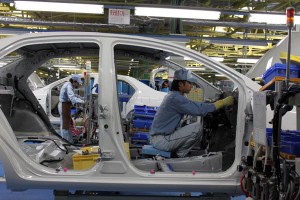In this article, we learn that Japan is looking for more alternative fuel-energy sources, and they have now turned to what was once considered an unlikely source, one that is being flushed out from every household everyday: SEWAGE! Indeed, Japan is researching on ways to turn sewage into an energy source by producing hydrogen from the bio-gas, making it a cleaner form of energy.
This is not an unexpected development in alternative energy. In California, a similar facility was commissioned, but has since been non-operational. How is Japan progressing when even countries as advanced as the United States is giving signals that today’s technologies are not ready to further this development? This is made possible through the support of the Japanese government, and also strong collaboration between industrial powerhouses, Toyota and Mitsubishi, as well as the Kyushu University, paving the way for Japan to be at the forefront of this green technology.
Then again, where does all this energy go to? Based on the companies involved, you would probably have guessed it right: vehicles. Although Japan is already implementing emission standards (JAMA, n.d.), they are going to take another step further in making zero-emission vehicles a possibility through this technology, by harnessing the hydrogen produced for fuelling hydrogen-powered cars. Despite being setback by natural and man-made disasters, Japan is determined to make known their capabilities in hydrogen technologies at the 2020 Olympics (Deign, 2015).
However, they are not without setbacks. For one, this development is still in the preliminary phases; right now it is taking up massive government subsidies to make this venture profitable for companies. Estimates suggest that without the subsidies from the Japanese government, the cost of hydrogen fuel would far exceed its current market price. To be exact, production cost is ten times as much as the cost of hydrogen fuel in today’s market.
As we’ve learnt from the past, it took twenty years to transition to automatic transmission (Thornton, 1997) and another twenty years for Japan to transition today’s hybrid-electric vehicles (Makinen, 2016). To make hydrogen fuel viable, experts suggest that further subsidies are required to accelerate the adoption of hydrogen-powered vehicles by the market (Nikkei, 2014). Only then would there be sufficient demand to make the market for hydrogen-powered vehicles viable.
Despite the vast powers of nature, the Japanese have been trying to shape nature with their hands, this time in the form of hydrogen technologies. Like “The Great Wave off Kanagawa”, this article depicts a power struggle between man and nature; man is about to be consumed by a great wave, that is global warming, and the men are desperately trying their best to escape this calamity, unsure if their efforts will bear fruits. This technology is somewhat like Japan’s efforts to quell global warming, but it remains ever so uncertain as to whether their efforts would yield desirable results.
References
Deign, Jason (2015). Green Tech Media, “Japan Makes a Big Bet on the Hydrogen Economy“.Last accessed on 23 Aug 2016.
JAMA (Japan Automobile Manufacturers Association, Inc.) (n.d.). “Japanese Government Incentives For The Purchase Of Environmentally Friendly Vehicles”. Last accessed on 23 Aug 2016.
Makinen, Julie (2016). Los Angeles Times, “Flush, Then Fill Up: Japan Taps Sewage To Fuel Hydrogen-Powered Cars“. Last accessed on 23 aug 2016.
Nikkei (Asian Review) (2014). Nikkei (Asian Review), “Japan’s Vision For Hydrogen Cars Lacks Oomph“. Last accessed on 23 Aug 2016.
Thornton, Emily. 1997. Bloomberg, “Japan’s Hybrid Cars“. Last accessed on 23 Aug 2016.
